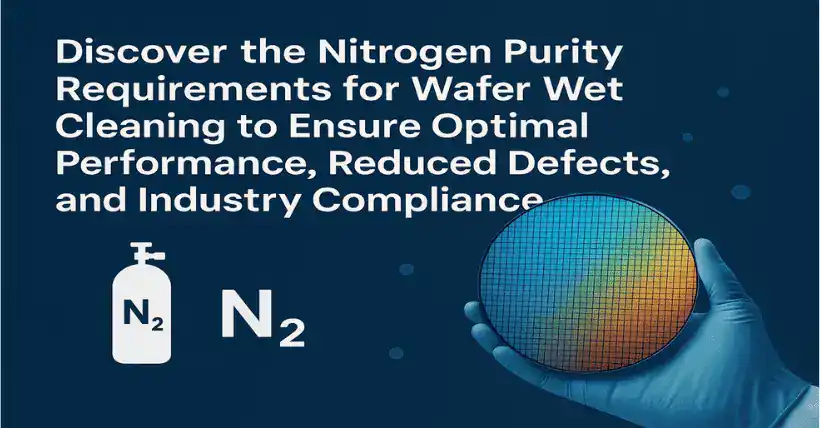The purity requirement of nitrogen (N₂) used for purging after wafer wet cleaning is critical, as it directly affects wafer surface cleanliness, drying effectiveness, and subsequent process yield. The key analysis is as follows:
01
Core Requirements of Wafer Wet Cleaning
Typical purity: ≥99.999% (5N); some advanced processes (e.g., EUV lithography) may require 99.9999% (6N).
Key impurity controls:
- Oxygen (O₂): <1 ppm (to prevent oxidation of residual contaminants or impact on metal layers).
- Water vapor (H₂O): Dew point ≤ -70°C (to avoid water stains leading to particle agglomeration or corrosion).
- Particulates: <0.1 μm (achieved via filters, e.g., 0.003 μm filter element).
- Other gases: Residual inert gases like argon (Ar) and helium (He) must be below ppb level.
02
Technical Basis
RCA Cleaning Standard: After SC1/SC2 wet cleaning, nitrogen purge is a standard step for rapid drying and forming an inert protective atmosphere.
SEMI Standards:
- F47-1101: Specifies total particle count in nitrogen ≤3.5×10⁴/m³ (≥0.1 μm).
- C79-13: Moisture content must be ≤10 ppb (equivalent to dew point ≤ -70°C).
Industry Practice:
Advanced processes (e.g., 3nm and below) demand stricter nitrogen purity. Some manufacturers adopt on-site nitrogen generation systems (PSA or membrane separation technology) to ensure real-time high-purity nitrogen supply.
03
Key Impact Factors
Consequences of insufficient purity:
- Oxidation risk: Residual O₂ may oxidize metal layers (e.g., Al, Cu), affecting electrical performance.
- Water stain residue: Incomplete H₂O removal may cause particle adhesion or chemical corrosion (e.g., NaCl solution residue).
- Particle contamination: Particles in nitrogen may recontaminate wafer surfaces, reducing yield.
Purge Process Optimization:
- Flow rate and angle: Use laminar or cyclone purge (flow rate 20–30 m/s) to ensure uniform drying of wafer surface.
- Temperature control: Preheat nitrogen to 30–50°C to accelerate moisture evaporation.
- Environmental isolation: Maintain chamber cleanliness during purging (Class 10 or better) to prevent external contamination.
The nitrogen purge purity requirement after wafer wet cleaning is typically above 99.999%, with strict control over O₂, H₂O, and particulate levels. Actual processes must integrate SEMI standards, process node requirements, and equipment capabilities (e.g., filter precision, gas supply systems) in design to ensure a residue-free wafer surface and meet the yield demands of critical steps such as lithography and etching.

Disclaimer:
- This channel does not make any representations or warranties regarding the availability, accuracy, timeliness, effectiveness, or completeness of any information posted. It hereby disclaims any liability or consequences arising from the use of the information.
- This channel is non-commercial and non-profit. The re-posted content does not signify endorsement of its views or responsibility for its authenticity. It does not intend to constitute any other guidance. This channel is not liable for any inaccuracies or errors in the re-posted or published information, directly or indirectly.
- Some data, materials, text, images, etc., used in this channel are sourced from the internet, and all reposts are duly credited to their sources. If you discover any work that infringes on your intellectual property rights or personal legal interests, please contact us, and we will promptly modify or remove it.



